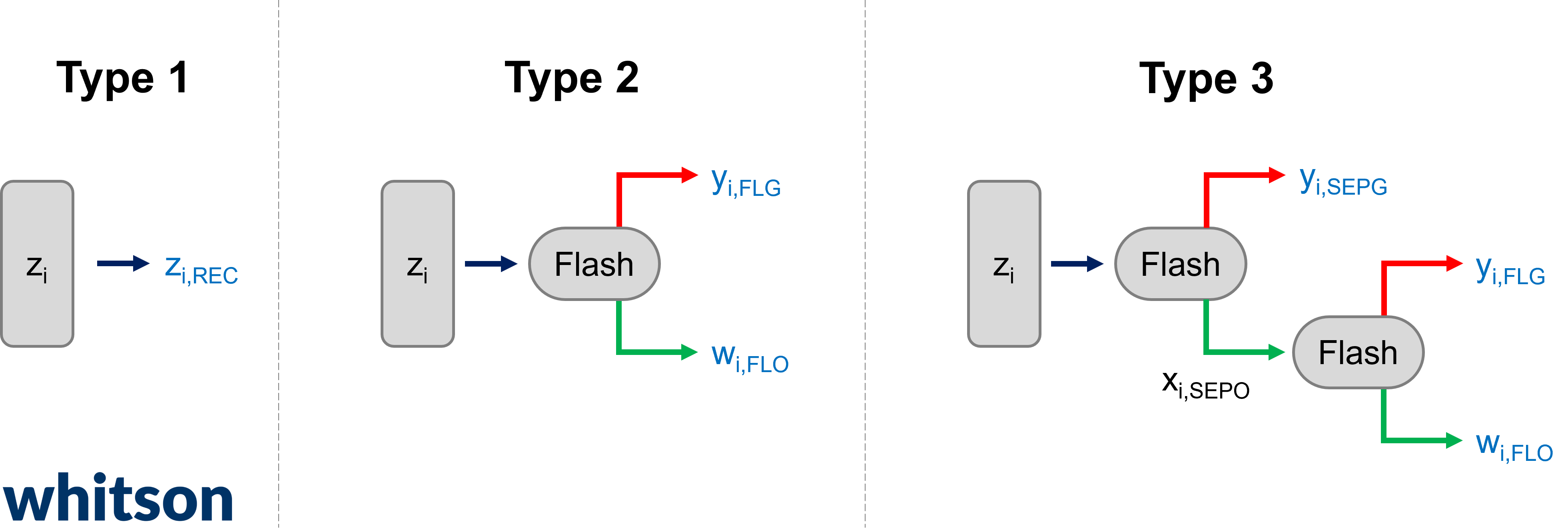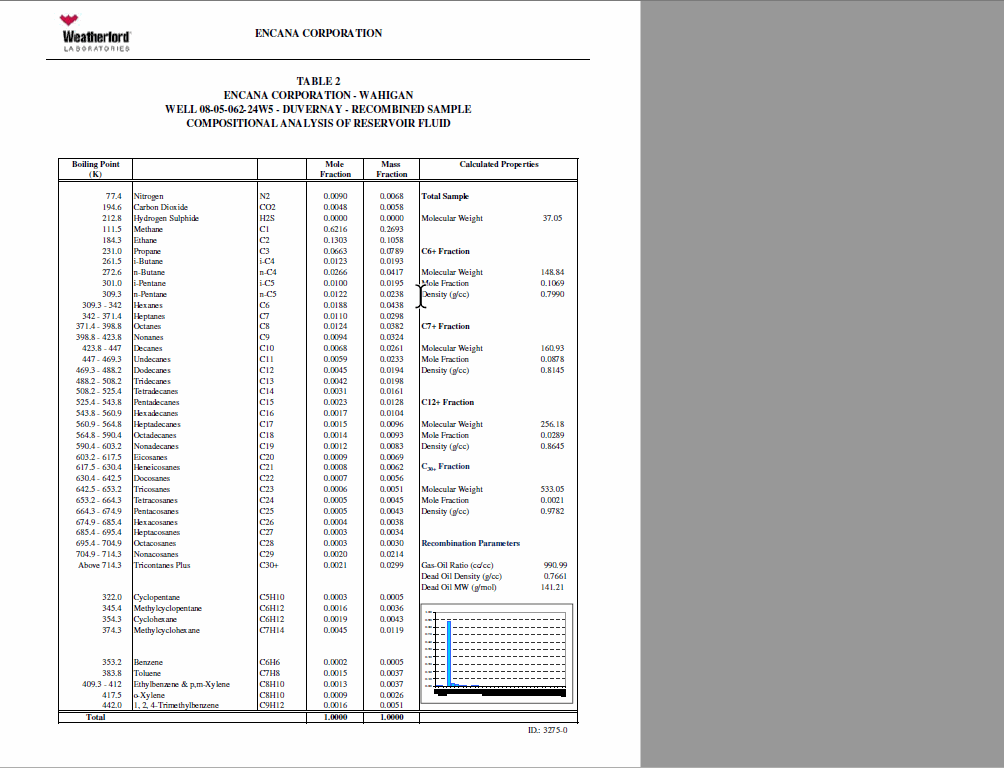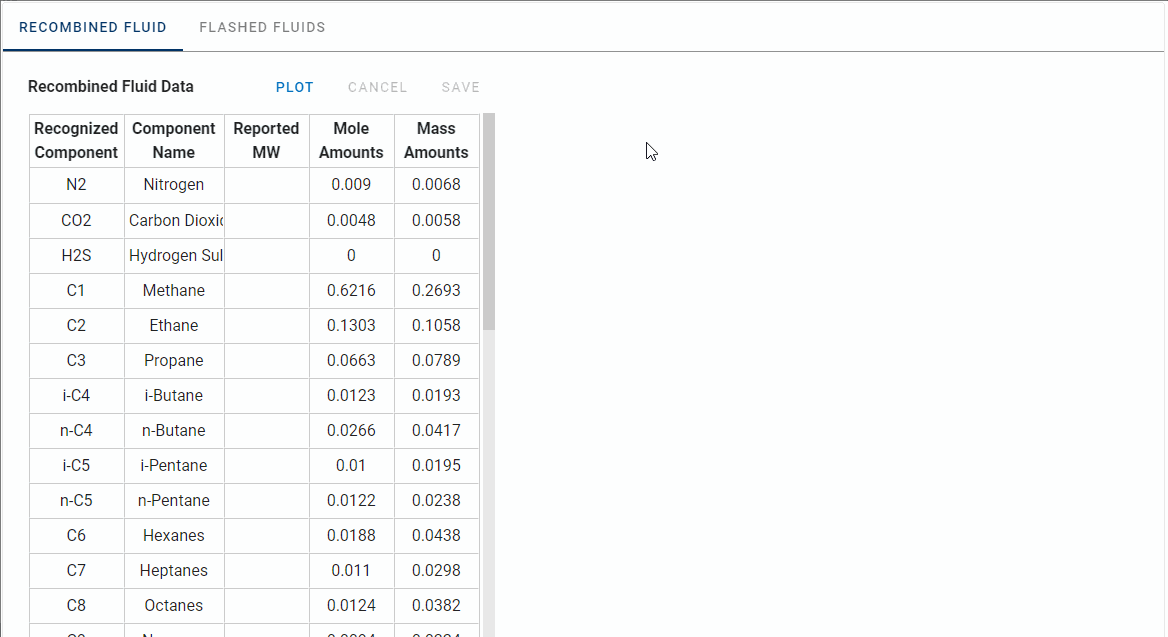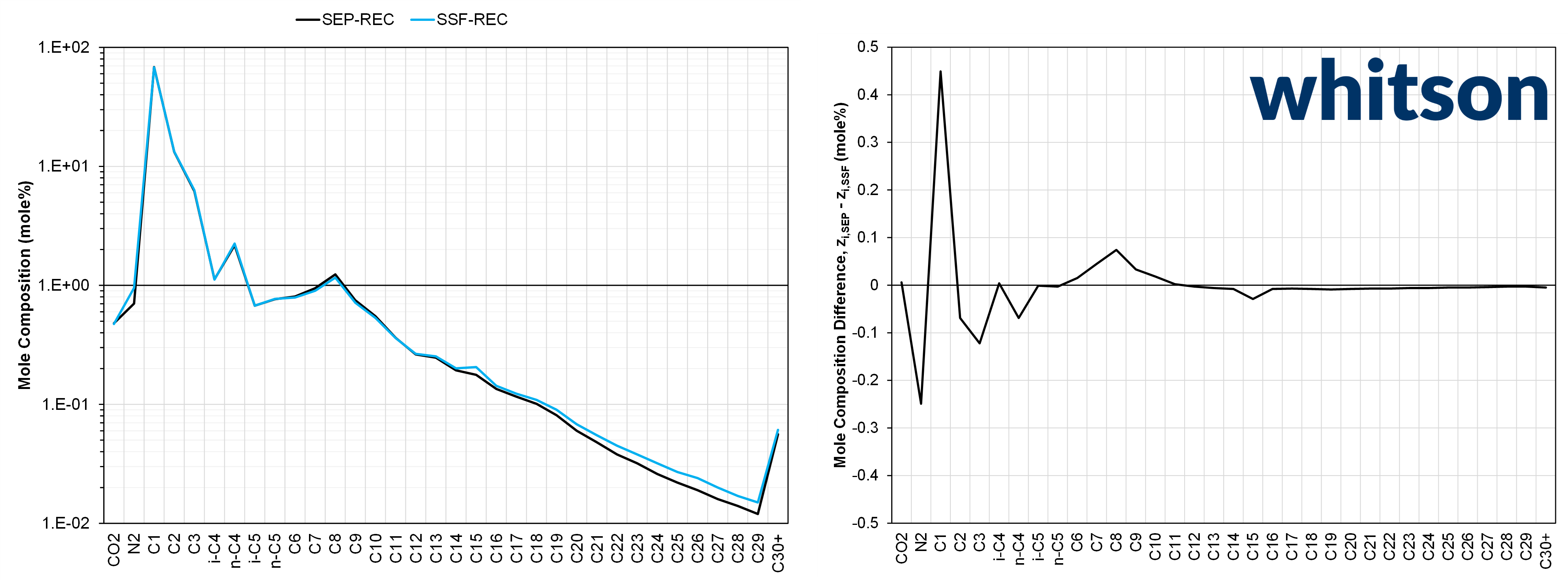Compositional Data Entry
What would we recommend if this is your first time?
Pay close attention to the examples below! The compositional data, especially the flashed oil data, is really important for C7+ characterization!

Figure 1 - Overview of different recombination types, and the compositional paths they take to get measured, and conversely how they are mathematically recombined to yield their recombined compositions.
For a detailed review of data entry of fluid samples, see the section on this topic here! Some specific examples are given in the sections below.
Most fluid samples are not measured, but are back-calculated from other fluids flashed to atmospheric pressure! Figure 1 shows the different compositional paths that different fluid samples can have, going from actually measured compositions (blue text) that are used to back-calculate the estimated recombined compositions reported as a mole composition.
In whitsonPVT there are two types of data that you can store in the Compositional Data tab. These data types are:
- Average fluid properties
- Component slates, reported molecular weights, and compositions (in mole and mass amounts).
Each data type is specified for each fluid in the compositional path. This allows whitsonPVT to perform the mathematical recombination in the background, and potentially compensate for recombination errors in the EOS Tuning feature.
The average fluid properties are composed of the following:
- Fluid molecular weight (all fluid types)
- Fluid density (for flashed oil and separator oil) or specific gravity (for flashed gas).
- Recombination GOR (for recombined fluids and separator oils)
- Temperature of two types: (1) flash temperature @ atmospheric pressure, and (2) separator fluid temperature @ separator pressure.
- Mud contamination amount (in mass% or mole%) if the mud type is set to oil-based mud.
The component properties are composed of a component name (required), a lab reported molecular weight (optional except for the residual fraction - for example C36+ - for which it is required), and a mole and / or mass amount (one of the two is required). If no component molecular weight is given, the Katz-Firoozabadi values are used for the C7+ single carbon number components. The heaviest fraction molecular weight is required in the slate-to-slate conversion when using the gamma model for flashed oil, or separator oil, or recombined compositions.
Oil-based mud compositions - Which one should you database?
If there is oil-based mud contamination, we recommend databasing the uncorrected composition, as the lab reported corrected composition is done on a sample-by-sample basis, and can sometimes be inaccurate or biased toward a straigh-line solution, which might not be correct. We recommend treating the whitsonPVT database as a digital copy of the measured data, as any modifications to the compositional or PVT data should be made in the context of all available samples in an area or fluid region!
Recombined Sample
A recombined sample is a general terminology for the different samples of Type 2 shown in Figure 1 with a single stage flash (SSF) process. Examples of recombined samples are:
- Surface recombined samples - REC
- Bottomhole samples - BHS
- Openhole formation test or MDT samples - OFT
- Wellhead samples - REC
- Separator oil samples - SEPO
Example 1 - Sample CL-63169 (Duvernay)
Flashed oil molecular weight - Calculated or measured?!
Make a note that the reported dead oil molecular weight and the flashed oil molecular weight under the calculated properties section on page 26 are exactly the same! This is a red flag (❗) that the reported flashed oil molecular weight used in the recombination calculation is calculated and not measured.
Note also that the calculated (0.7865 g/cm3) and reported (0.7661 g/cm3) flashed oil density are not the same, which makes sense, as the flashed oil density is usually measured.
This sample's data can be found in this PVT report on pages 3, 4, 26, and 27. The average fluid properties are:
- Recombined fluid:
- Fluid molecular weight (calculated): 37.05
- Recombination GOR (measured): 990.99 (Sm3/Sm3)
- Flashed fluids:
- Flashed gas molecular weight (calculated): 23.54
- Flashed gas specific gravity (calculated): 0.8128 (unit=SG)
- Flashed oil molecular weight (reported): 141.21
- Flashed oil density (measured): 0.7661 g/cm3
- Flash temperature: 60°F
A tip to speed up your data entry - Having trouble digitizing the data?
First, we recommend using the Adobe for handeling PDF files. Adobe Acrobate Reader is a free to use software that works great for extracting data from PDF files!
As an example, if you want to grab a column of data in Adobe Acrobate Reader, this is as simple as holding ALT and using your mouse cursor to select the data you want to copy!

The compositional data for the recombined fluid is taken from page 4 along with the C30+ molecular weight. The flashed oil composition are taken from page 25, with the same C30+ molecular weight as the recombined fluid only given on page 4. The component names are taken from the Component Name column, not the Chemical Symbol column, because the chemical symbols for certain components are non-unique (e.g. i-C5 and n-C5).
A tip to speed up your data entry - Copy your component slate!
If you see that you have the same component slate for your recombined and flashed oil fluids, you don't have to re-select in the PDF PVT report, but you can utilize some of the neat features in whitsonPVT.
The trick here is to click where it says Component Name in the whitsonPVT for the Recombined Fluid Data table. This will select the entire column. Now by holding the SHIFT key and clicking the RIGHT ARROW key you will select the second column with the heaviest component molecular weight. Then you can simply copy-pase (CTRL+S then CTRL+V) in the Flashed Oil Data in the Flashed Fluids tab!

The flashed gas composition is taken from page 27. In this case we can take the component names from the Chemical Symbol column. For the mole amounts, we want to take the compositions as analyzed, as the removal of N2 is somewhat arbitrary.
By plotting the recombined fluid and / or flashed oil fluid, we can clearly see that there is something wrong with the compositional data for the C29 component. It makes a sudden jump up to a much higher value than it should be! The reason we expect this for the heaviest fraction is because it is the sum of the all remaining components. In fact, whitsonPVT has already indicated this issue when entering the data! How? Well, when entering the flashed oil composition, the amounts don't sum to 1 or 100, and this is flagged automatically by whitsonPVT as a warning!
Example 2 - Sample 2.08+2.09-SSF (Duvernay)
This sample's data can be found in this PVT report on pages 31, and 32. The average fluid properties are:
- Recombined fluid:
- Fluid molecular weight (calculated): 30.2
- Recombination GOR (measured): 12200.8 (scf/STB)
- Flashed fluids:
- Flashed gas molecular weight (calculated): 23.4
- Flashed gas specific gravity (calculated): 0.808 (unit=SG)
- Flashed oil molecular weight (calculated): 151.9
- Flashed oil density (measured): 777 g/cm3
- Flash temperature: 60°F
Example 3 - Sample TS-29-06 from Well 15/9-19SR (Volve)
A tip to speed up your data entry - Having trouble digitizing the data?
If you can't select data in a PDF file, this is most likely because the PDF is not OCR converted! You can extract data from these files by running an OCR scan on the document, or use a software like this to convert a table to an OCR file.
This sample's data can be found in this PVT report on pages 3, 5, and 7. The average fluid properties are:
- Recombined fluid:
- Fluid molecular weight (calculated): 101.48
- Recombination GOR (measured): 159.1 (Sm3/Sm3)
- Flashed fluids:
- Flashed gas molecular weight (calculated): 25.63
- Flashed gas specific gravity (calculated): 0.885 (unit=SG)
- Flashed oil molecular weight (reported): 240.5
- Flashed oil density (measured): 0.883 g/cm3
- Flash temperature: 15°C
The recombined composition was taken from page 7 as it was given with more detail (up to C20+). The flashed gas and flashed oil compositions were taken from page 5. The component molecular weights were taken from page 5 for the C9- components, and from page 7 for the C10+ components.
Example 4 - Sample 6103-MA well 15/9-F4 (Volve)
This sample's data can be found in this PVT report on pages 12, 17, 18, 19, and 20. The average fluid properties are:
- Recombined fluid:
- Fluid molecular weight (calculated): 119.1
- Recombination GOR (measured): 109.8 (Sm3/Sm3)
- Flashed fluids:
- Flashed gas molecular weight (calculated): 25.46
- Flashed gas specific gravity (calculated): 0.879 (unit=SG)
- Flashed oil molecular weight (reported): 237.6
- Flashed oil density (measured): 872.5 kg/m3
- Flash temperature: 22.4°C
- Mud filtrate contamination in flashed oil: 12.5 mass%
The recombined, flashed gas, and flashed oil compositions and component names was taken from page 20 as it was given with more detail (up to C36+). The component molecular weights were taken from page 19. The average properties are found on pages 12 (lab reported mud contamination amount), 17, and 18.
Example 5 - Separator oil sample AM5179 (Duvernay)
This is a separator oil sample used in the physical recombination to generate sample CL-63169 (see Example 1 in the recombined sample section), and its sample data can be found in this PVT report on pages 90, 91, 92, 93, and 94. The average fluid properties are:
- Recombined fluid:
- Fluid molecular weight (calculated): 76.60
- Recombination GOR (measured): 170.22 (Sm3/Sm3)
- Flashed fluids:
- Flashed gas molecular weight (calculated): 32.67
- Flashed gas specific gravity (calculated): 1.1279 (unit=SG)
- Flashed oil molecular weight (reported): 130.38
- Flashed oil density (measured): 765.5 kg/m3
- Flash temperature: 60°F
The compositional data for the separator oil fluid is taken from page 92 along with the C30+ molecular weight. The flashed oil composition from the separator oil are taken from page 93, with the same C30+ molecular weight as the recombined fluid only given on page 92. The component names are taken from the Component Name column, not the Chemical Symbol column, because the chemical symbols for certain components are non-unique (e.g. i-C5 and n-C5). The flashed gas composition are taken from page 94, where the chemical symbol is used, and the mole composition is taken from the column called "As Analyzed".
Separator Sample
What would we recommend if this is your first time?
If the lab reports both a separator recombined and SSF recombined composition for the physically recombined sample in the PVT cell, make two different samples in whitsonPVT. You can add the PVT data to both samples and see which composition gives the best results in the EOS Tuning feature.
Separator recombined samples (SEP), sometimes called physically recombined samples, are a slightly more complicated recombined sample, defined by Type 3 in Figure 1. Once a separator recombined sample is physically recombined in the laboratory, in a PVT cell, part of the fluid is then sometimes extracted, then re-flashed as a Type 2 process. The flashed gas and oil fluid compositions are then measured with the average data, and mathematically back-calculated. This composition might deviate slightly from Type 3 separator recombined back-calculated composition, and is an indication of the uncertainty in the overall composition used in fluid model predictions!
Example 1 - Sample 2.08+2.09 (Duvernay)
Missing data - Separator recombined molecular weight
The calculated average molecular weight of the separator recombined fluid for sample 2.08+2.09 is not reported in the PVT report. This is most likely an oversight in the data entry from the laboratory. In this case, we can calculated the average molecular weight (\(M_{SEP}\)) using the following equation:
This can also be done in Excel using the function:
=SUMPRODUCT(MOLE_COMPOSITION_LIST, MOLECULAR_WEIGHT_LIST)/SUM(MOLE_COMPOSITION_LIST)
This sample's data can be found in this PVT report on pages 27, 28, 29 and 30. The average fluid properties are:
- Recombined fluid:
- Fluid molecular weight (calculated): 29.9
- Recombination GOR (measured): 10740 (scf/separator bbl)
- Separator fluids:
- Separator gas molecular weigth (calculated): 22.8
- Separator oil molecular weigth (calculated): 134.9
- Separator oil density (calculated): NOT REPORTED
- Separator oil GOR (calculated): 5.562 (Sm3/Sm3)
- Flashed fluids:
- Flashed gas molecular weight (calculated): 34.5
- Flashed gas specific gravity (calculated): 1.193 (unit=SG)
- Flashed oil molecular weight (reported): 139.180
- Flashed oil density (measured): 0.773 g/cm3
- Flash temperature: 60°F
The separator gas composition was taken from page 27 (from sample 2.08). The separator oil composition and its flashed fluids were taken from page 28. The recombined compositions, component names, and component molecular weights were all taken from page 30.
The PVT cell containing the recombined separator gas (2.08) and separator oil (2.09) samples, has two different mathematically estimated compositions! The separator recombined sample is given above, while the recombined (single stage flash) sample is given in this section. The difference in compositions is given below as a set of plots.

Figure 2 - The left plot shows the separator recombined mole composition (SEP-REC) and the single stage flash recombined mole composition (SSF-REC). The right plot shows the difference between the two different estimates in compositions for the same fluid.
Figure 2 clearly shows a significant deviation in the methane content (0.45 mole%), which will have an impact on the phase behavior calculations for this gas condensate fluid! Which one is correct? We recommend adding the PVT data to both samples, and see which sample gives the best predictions in the EOS Tuning feature.
Separator Gas Sample
Example 1 - Separator gas sample CYL4025 (Duvernay)
This is a separator gas sample used in the physical recombination to generate sample CL-63169 (see Example 1 in the recombined sample section), and its sample data can be found in this PVT report on pages 86 and 87. The average fluid properties are:
- Separator Gas Information
- Specific gravity (calculated): 0.7105
The separator gas compositions and component names was taken from page 87 where the chemical symbol is used foir the component name, and the mole composition is taken from the column called "As Analyzed". No component molecular weights were needed.
Next Step
The next step is to add the PVT experiment data!